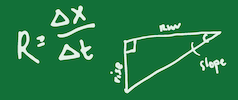Initial Publication Date: August 16, 2024
Guiding students through Orders of Magnitude
An instructor's guide to Orders of Magnitude
Dori Farthing (SUNY Geneseo)
Susan Bilek (New Mexico Institute of Mining and Technology)
What should students get out of this module?
After completing this module, a student should be able to:
- Estimate the order of magnitude of a number
- Calculate the order of magnitude of a number
- Compare geologically relevant numbers using estimated or calculated orders of magnitude
Why are these math skills challenging to incorporate into courses?
- We, and our students, have been trained to think of calculations and measurements as having specific and exact numerical answers. Estimated and calculated orders of magnitude are approximate values, and for many, that may be challenging. Imagine trying to determine the volume of a lake. Natural lakes don't have angular 3D geometries and so our calculation of their volume is truly our best approximation. Two researchers might determine slightly different volumes for the same lake, but if they are the same order of magnitude, that is acceptable in many cases. Many students yearn to know exact values and approximations feel unsettling.
- Earth scientists deal with data that are both very large (e.g., geological time) and very small (e.g., atomic scale), and such measurements are challenging for students to envision. Comparisons of estimated or calculated orders of magnitude can be equally challenging for our brains to comprehend (e.g., if two distances differ by 16 orders of magnitude, it suggests that they are approximately 1016 times different and comprehending that difference may be difficult to conceptualize).
- Earth scientists have not always used the term "order of magnitude" correctly.
- For example, researchers might report that something has an order of magnitude of 1015 when what they really mean is that their measurement's order of magnitude is 15. Our lack of precision with the terminology leads to confusion.
- This module differentiates between estimated and calculated orders of magnitude. Many Earth scientists use estimated orders of magnitude, but that can cause problems when comparing values that are close and are approximated by the same power of 10. For example, the two numbers 9 and 12 would have different estimated orders of magnitude (0 and 1), but when the orders of magnitude are calculated, they both have a magnitude of 1.
- A note of warning to you and to your students....there are on-line calculators for order of magnitude, but they may not give the correct answer because they don't round to the nearest power of 10 before determining the correct calculated order of magnitude.
- IMPORTANT: There is a common misconception that all one needs to do to determine an order of magnitude is to count the number of digits between a number and a decimal instead of using the technique we have defined in this module. The counting method provides the estimated order of magnitude, but when it comes to robust calculated orders of magnitude, rounding matters! For example, 900 must be rounded to 1000 to determine its calculated order of magnitude. Using the log method will always work for calculated orders of magnitude.
What don't we include in the module?
- Approximations/estimations and the use of orders of magnitude are related. There are times when approximations/estimates are appropriate and times when they are not. This module does not provide guidance on when estimation is appropriate rather than obtaining a detailed numerical value nor does it provide guidance on how to determine an estimate.
- Rounding, logarithms, and scientific notation are used in the calculations of this module but are not taught in the module. Links to other teaching modules regarding logarithms and scientific notation have been provided.
- We have also not included any of this historical background regarding the concept of "order of magnitude". If you are interested in reading about its origins and the work by Bachmann who coined the phrase in 1894, the Mathematical Association of America has a nice overview.
- We don't talk much about the difference between scale and orders of magnitude. Scale comparisons will allow for values that are not just whole numbers (i.e., one brachiopod is 1.5 x longer than another). Order of magnitude comparisons are solely based on powers of 10.
- We focus on values that are in SI units (e.g., metric for length scales). If you are using non-metric length scales in your class, please be very clear about the units and conversions.
- We also don't include any examples on how changing the size of a value by orders of magnitude helps test variable sensitivity in an equation.
Instructor resources
Support for teaching this quantitative skill
- This image is one that might help students visualize differences in size:
 ×
× - This open access physics textbook has a nice section on units and standards that also includes information regarding order of magnitude. It also offers good insight regarding the math and rounding that is needed to calculate orders of magnitude.
- If you would like to give your students practice with estimating sizes and numbers, Fermi questions are a great way to do this. These sorts of calculations are all about scientific notation and order of magnitude and this resource might be of help: OER related to estimating
Examples of activities that use this quantitative skill
- Incomprehensibly Small and Incomprehensibly Large--an exercise created to teach about a variety of scales that could be merged with order of magnitude exercises
- Stream Discharge module - a set of activities looking at variations in stream discharge data over time, especially in the context of flood events.
- This is a module aimed at introducing students to estimation in sedimentological studies. Orders of magnitude could be easily incorporated into assessing one estimate compared to another.
